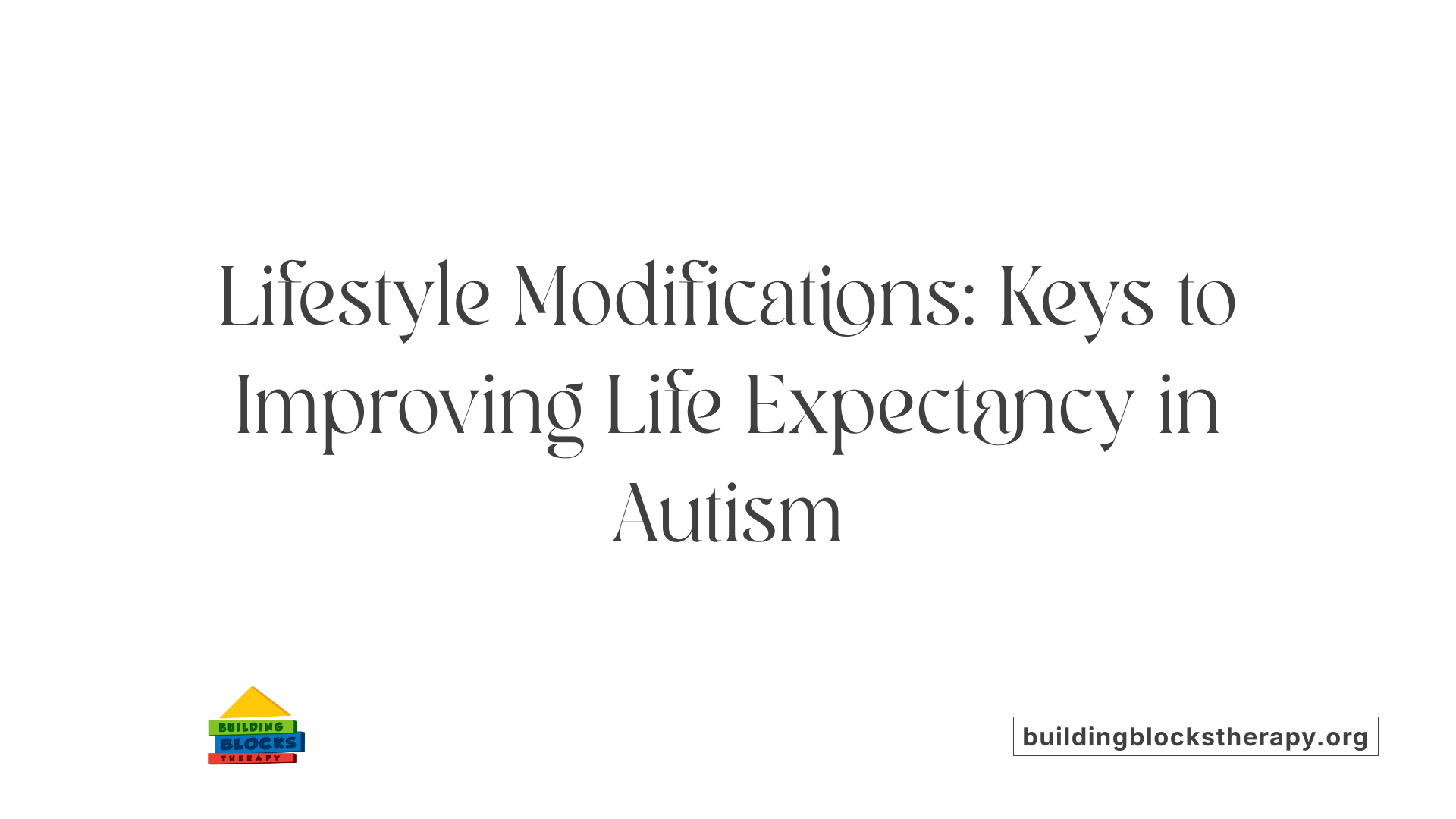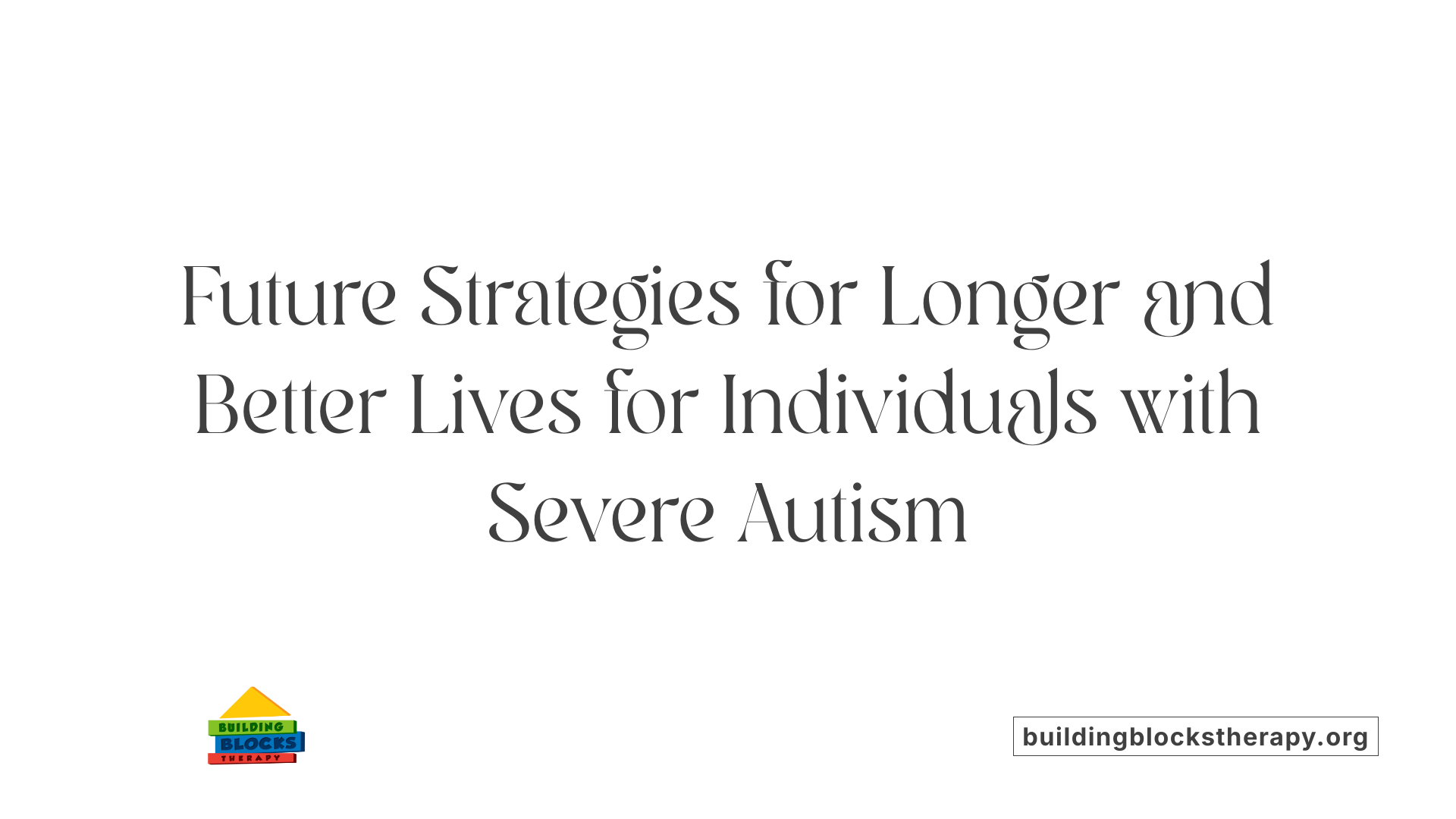Level 3 Autism Life Expectancy
Examining Life Expectancy and Therapeutic Interventions in Severe Autism

Understanding Life Expectancy in Level 3 Autism
Individuals with Level 3 Autism Spectrum Disorder (ASD), characterized by severe symptoms and significant support needs, face distinct challenges impacting their life expectancy. Research indicates a notable disparity in lifespan compared to the general population due to a complex interplay of health issues, lifestyle factors, and systemic barriers. This article explores these factors comprehensively and highlights the role of behavioral therapies, particularly Applied Behavior Analysis (ABA), in improving health outcomes and quality of life for this vulnerable group.
Life Expectancy Realities and Contributing Factors in Level 3 Autism

What is the life expectancy for individuals with Level 3 autism compared to the general population?
Individuals with Level 3 autism, often characterized by severe symptoms and intellectual disabilities, show a notably reduced life expectancy compared to the general population. Research from the United States estimates an average lifespan of about 36 years for autistic individuals with severe conditions, contrasted with approximately 72 years for the overall population. Similarly, Swedish data indicates an average age of death around 39.5 years for those with cognitive or learning disabilities linked to autism, versus later ages for those without.
This dramatic difference—ranging from 20 to 36 years shorter—highlights the vulnerability of this group. Factors including co-occurring intellectual disability greatly lower lifespan, sometimes resulting in death before age 40.
What are the major causes contributing to premature death in those with severe autism?
Premature death among individuals with Level 3 autism stems from a variety of serious causes. Injuries such as drowning, suffocation, and poisoning rank highly. The risk of drowning is particularly elevated in young children around ages 5 to 7. Nervous system disorders, especially epilepsy—which affects 20–40% of autistic people—also contribute significantly to mortality, with some cases proving resistant to treatment.
Heart disease is another major factor, alongside mental health challenges. Depression, anxiety, and other psychiatric conditions increase suicide rates dramatically; autistic individuals are reported to have suicide risks multiple times that of the general population.
How do comorbidities impact lifespan in severe autism?
Co-occurring medical conditions have a substantial influence on life expectancy within this population. Neurological issues like epilepsy escalate health risks considerably. Additionally, gastrointestinal problems, sleep disorders, and sensory processing difficulties complicate health management.
Mental health comorbidities such as obsessive-compulsive disorder and depression further exacerbate vulnerabilities. These complex conditions often require tailored, multidisciplinary care to mitigate premature mortality risks.
What is the role of intellectual disability and epilepsy in affecting life expectancy?
Intellectual disability commonly seen in Level 3 autism is tightly linked to higher mortality rates. Autistic individuals with intellectual disabilities tend to die decades earlier than those without. Epilepsy, one of the most prevalent neurological comorbidities, can be particularly severe in this group, increasing risks for sudden death and complicating overall medical care.
Management of epilepsy through early detection, medication adherence, and lifestyle adjustments is crucial to improving survival chances.
How do health inequalities and systemic barriers influence outcomes for those with severe autism?
Health disparities greatly worsen life expectancy outcomes. Barriers include delayed or missed diagnosis, limited healthcare access, and insufficient tailored services. Social exclusion and unemployment also play roles, as do poor communication between patients, families, and providers.
Many autistic individuals face challenges obtaining timely mental and physical healthcare, which amplifies risks from otherwise manageable conditions. Efforts to enhance healthcare provider training, improve support systems, and promote inclusive policies are essential to reducing these inequalities and extending lifespan.
| Factor | Impact on Life Expectancy | Notes |
|---|---|---|
| Intellectual Disability | Reduces lifespan by over 30 years | Strongly associated with early death before age 40 |
| Epilepsy | Increases mortality risk | Affects 20-40% of autistic individuals; treatment-resistant cases raise risk |
| | Injuries (drowning, suffocation) | Leading cause of death | Drowning risk peaks at ages 5-7; safety interventions critical| | | Mental Health Disorders | Raises suicide risk significantly | 9x higher suicide rate than general population | | Health Inequalities | Worsens outcomes | Includes delayed diagnosis, poor healthcare access |
This complex interplay of factors underscores the urgent need for comprehensive, individualized care and systemic reforms to improve life prospects for individuals with severe autism.
Impact of Lifestyle and Health Behaviors on Life Expectancy in Autism

How do lifestyle factors influence health outcomes and longevity in autistic individuals?
Lifestyle factors such as diet, exercise, and sleep play a crucial role in shaping health outcomes and life expectancy among autistic adults. Research shows that individuals with autism spectrum disorders (ASD) often struggle to meet minimal guidelines for these lifestyle behaviors, which negatively affects their overall health.
Diet, exercise, and sleep in autistic adults
Many autistic adults experience atypical eating patterns, including selective or limited diets. Combined with disturbances in sleep and irregular physical activity, these issues contribute to poorer health outcomes. In particular, altered sleep patterns can aggravate mental health challenges, while insufficient exercise may lead to increased cardiovascular risks.
Atypical eating patterns and weight issues
Weight problems in autistic individuals are common, with some being underweight and others obese. Both extremes are linked to a higher likelihood of developing health complications. Atypical eating patterns—often restrictive or repetitive—impact nutritional intake and further exacerbate these weight challenges.
Cardiovascular risk factors
For males with ASD, lifestyle factors like diet, physical activity, and sleep have an even greater impact on cardiovascular disease risk than family medical history. This highlights the significant role that modifiable behaviors can play in reducing heart-related health problems.
Importance of lifestyle modifications
Intervening to improve diet quality, encourage regular exercise, and normalize sleep patterns can potentially lower the risk of health comorbidities and premature death among autistic adults. Tailored healthcare strategies and support systems that focus on behavioral and lifestyle changes are essential to enhancing life expectancy and quality of life. These approaches must address the unique challenges faced by autistic individuals to be effective.
| Area | Issues in Autistic Adults | Impact on Health and Longevity |
|---|---|---|
| Diet | Atypical eating patterns, selective eating | Nutritional deficiencies, weight problems |
| Exercise | Lower rates of physical activity | Increased cardiovascular risk |
| Sleep | Disturbances and irregular sleep patterns | Worsened mental health, increased physical health risks |
| Cardiovascular Risk | Greater lifestyle impact than family history (males) | Elevated heart disease risk, early mortality |
Healthcare Access, Comorbidities, and Their Influence on Longevity

How do healthcare access and comorbid conditions affect life expectancy in Level 3 autism?
Early diagnosis and consistent access to healthcare are crucial for improving health outcomes and extending lifespan in individuals with severe autism. Timely identification allows for management of associated medical conditions and promotes better overall care.
Many autistic individuals face co-occurring medical and neurological disorders that increase their health risks. Conditions such as epilepsy—affecting approximately 20–40% of autistic people, particularly those with intellectual disabilities—can raise the risk of premature death if not effectively managed. Genetic syndromes like Down syndrome and Fragile X, along with gastrointestinal and sleep disorders, further complicate health profiles and require specialized medical attention.
Mental health challenges are also prevalent, with high rates of anxiety, depression, and suicidal ideation reported. In fact, suicide rates among those with autism can be up to nine times higher than in the general population. This highlights the urgent need for tailored mental health support and environments that foster understanding and acceptance.
Despite the high burden of comorbidities, systemic barriers often prevent autistic individuals from receiving adequate care. These include delayed diagnoses, social isolation, unemployment, and lack of appropriate support services. Such barriers contribute to poorer quality of life and shorter life expectancy.
Proactive healthcare strategies are essential to mitigate these challenges. Regular health screenings, clear communication of symptoms, coordinated care involving families and providers, and education about specific risks can all contribute to better health outcomes. Additionally, supporting families and caregivers through counseling and respite services is vital, as their well-being directly impacts the care autistic individuals receive.
Through comprehensive and personalized approaches that address both medical and social factors, many people with severe autism can achieve longer, healthier lives.
Applied Behavior Analysis (ABA) Therapy: A Cornerstone of Autism Treatment

What is Applied Behavior Analysis (ABA) therapy, and how is it used in autism treatment?
ABA therapy is a scientifically supported, individualized behavioral approach designed to help individuals with autism spectrum disorder (ASD) improve specific skills and reduce behaviors that interfere with learning and daily life. This therapy uses principles of learning theory by reinforcing positive behaviors and applying consistent techniques to teach communication, social interaction, and self-care skills. Widely regarded as the gold standard in autism treatment, ABA incorporates methods such as Discrete Trial Training (DTT), Pivotal Response Treatment (PRT), and the Early Start Denver Model (ESDM).
What are the main goals and techniques used in ABA therapy for individuals with autism?
The main goals of ABA therapy include enhancing communication abilities, social interactions, and adaptive behaviors while decreasing harmful or challenging behaviors. Treatment is highly personalized and employs techniques like positive reinforcement, functional behavior assessments, and targeted interventions tailored by certified behavior analysts. Sessions tend to be intensive and long-term to encourage consistent developmental progress.
What evidence supports the effectiveness of ABA therapy in autism treatment?
Numerous controlled studies support ABA’s effectiveness in improving social communication skills and reducing problematic behaviors in individuals with autism. Empirical research demonstrates meaningful gains in adaptive functioning when ABA is delivered consistently over time. The American Psychological Association officially recognizes ABA as an evidence-based therapy for ASD, underscoring its substantial impact on enhancing functional outcomes and quality of life.
| Aspect | Description | Impact |
|---|---|---|
| Definition and Goals | Individualized behavioral therapy aiming to teach positive skills and reduce negative ones | Improves communication, social, and adaptive behaviors |
| Techniques | Uses DTT, PRT, ESDM, positive reinforcement, and functional assessments | Provides structured, research-backed interventions |
| Evidence | Supported by multiple studies and APA endorsement | Demonstrates significant gains in social and functional skills |
| Role in Development | Focuses on skill building and behavior adjustment through intensive sessions | Enhances life quality and independence for individuals with autism |
Professional Expertise and Delivery of ABA Therapy
Who provides ABA therapy and what qualifications do the professionals have?
ABA therapy is delivered by a team of skilled professionals trained in applied behavior analysis methods. The primary providers include Board Certified Behavior Analysts (BCBAs), Registered Behavior Technicians (RBTs), and behavior analysts.
BCBAs hold graduate degrees in behavioral science or related fields and have completed extensive supervised experience hours. They obtain certification by passing a comprehensive exam administered by the Behavior Analyst Certification Board (BACB). This certification assures compliance with strict standards related to assessment, behavior intervention design, and ethical practice.
Registered Behavior Technicians (RBTs), on the other hand, are paraprofessionals who complete specialized training and competency evaluations. They implement treatment plans directly, working under the close supervision of BCBAs or qualified behavior analysts.
The therapy is often provided within specialized clinics or educational settings where providers follow evidence-based, research-validated interventions. Ethical guidelines emphasize client dignity, informed consent, and individualized treatment planning.
Together, these professionals form a structured team ensuring quality ABA service delivery optimized for the unique needs of each individual receiving therapy.
Future Directions: Enhancing Life Expectancy and Quality of Life for People with Severe Autism

What strategies can improve life expectancy and quality of life for individuals with severe autism?
Improving life expectancy and quality of life for people with severe autism requires an integrated approach combining behavioral and medical interventions. Comprehensive medical care must address the unique physical, neurological, and mental health challenges often experienced by autistic individuals, such as epilepsy and anxiety. Behavioral therapies, like Applied Behavior Analysis (ABA), complement medical treatments by supporting communication, social skills, and adaptive behaviors tailored to individual needs.
Tailored healthcare and well-designed support systems are essential. Personalized care plans should include regular screening for co-occurring conditions, proactive management of health risks, and psychiatric support for mental health challenges such as depression and suicidality. Creating structured, clear, and understanding healthcare environments encourages timely access to treatment and builds trust.
Family support and community involvement play a critical role. Educating families about autism and associated health risks, providing respite care and counseling, and fostering robust community connections can alleviate caregiver stress. Well-supported families are better equipped to participate in care coordination, improving overall outcomes for individuals with ASD.
Ongoing research and innovations continue to advance understanding and care for severe autism. Efforts focus on early diagnosis, personalized therapies, and addressing social determinants of health. Emphasizing health equity and reducing systemic barriers ensures all autistic people can access quality services, reducing health inequalities that currently contribute to premature mortality.
In summary, a multifaceted strategy that combines personalized medical and behavioral care, strong family and community support, continual research, and equitable healthcare access holds the greatest promise for enhancing life expectancy and quality of life in individuals with severe autism.
Towards Longer, Healthier Lives for Individuals with Level 3 Autism
Life expectancy for individuals with Level 3 autism remains a complex issue shaped by medical, behavioral, and social factors. While statistics reveal significant challenges, advances in early diagnosis, specialized care, and evidence-based behavioral therapies like ABA offer hope for meaningful improvements. Addressing lifestyle factors, comorbidities, healthcare access, and family support comprehensively can narrow the life expectancy gap. Continued innovation, education, and systemic change are essential to ensure that individuals with severe autism can lead healthier, fuller lives with dignity and opportunity.
References
- Lifestyle issues play role in shorter life expectancy
- Autism Spectrum Disorder and Premature Death
- People With Autism Die Earlier, but Only by a Little
- Early Death in Those with Autism Spectrum Disorder
- Chapter 3 – Parliament of Australia
- Applied Behavior Analysis (ABA)
- Applied Behavior Analysis (ABA)






